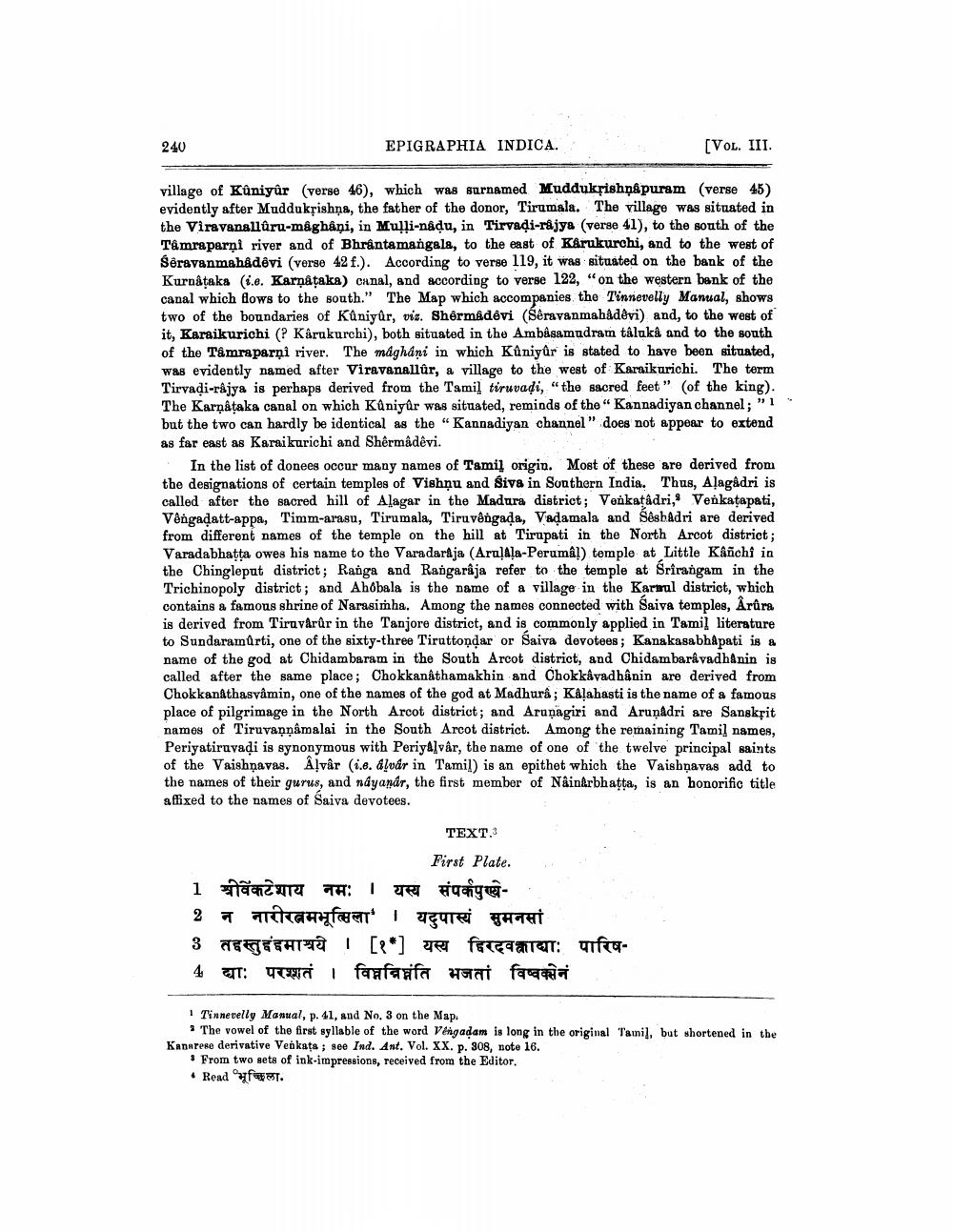________________
240
EPIGRAPHIA INDICA.
[VOL. III.
village of Kuniyûr (verse 46), which was surnamed Muddukfishņ&puram (verse 45) evidently after Muddukrishna, the father of the donor, Tirumala. The village was situated in the Viravanallûru-maghåni, in Mulli-nâļu, in Tirvaţi-rajya (verse 41), to the south of the Támraparņi river and of Bhrántamangala, to the east of Karukurchi, and to the west of Sêravanmahadevi (verse 42 f.). According to verse 119, it was situated on the bank of the Kurnataka (i.e. Karnataka) canal, and according to verse 122, "on the western bank of the canal which flows to the south." The Map which accompanies the Tinnevelly Manual, shows two of the boundaries of Kuniyûr, viz. Shêrmêdêvi (Sêravanmahadevi) and, to the west of it, Karaikurichi (P Kárukurchi), both situated in the Ambasamudram tåluka and to the south of the Tamraparni river. The mágháni in which Kuniyûr is stated to have been situated, was evidently named after Viravanallûr, a village to the west of Karaikurichi. The term Tirvadi-rajya is perhaps derived from the Tamil túruvadi," the sacred feet" (of the king). The Karnataka canal on which Kuniyur was situated, reminds of the "Kannadiyan channel;" 1 but the two can hardly be identical as the "Kannadiyan channel" does not appear to extend as far east as Karaikurichi and Shermadêvi.
In the list of donees occur many names of Tamil origin. Most of these are derived from the designations of certain temples of Vishnu and Siva in Southern India. Thus, Alagadri is called after the sacred hill of Alagar in the Madura district; Venkatádri, Venkatapati, Vångadatt-appa, Timm-arasu, Tirumala, Tiruvêngada, Vadamala and Seshadri are derived from different names of the temple on the hill at Tirupati in the North Arcot district; Varadabhatta owes his name to the Varadaraja (Aru!Aļa-Perumal temple at Little Kanchi in the Chingleput district; Ranga and Rangaraja refer to the temple at Srirangam in the Trichinopoly district; and Ahobala is the name of a village in the Karmal district, which contains a famous shrine of Narasimha. Among the names connected with Saiva temples, Arûra is derived from Tiruvarur in the Tanjore district, and is commonly applied in Tamil literature to Sundarainurti, one of the sixty-three Tiruttoņdar or Saiva devotees ; Kanakasabhapati is a name of the god at Chidambaram in the South Arcot district, and Chidambaravadhanin is called after the same place; Chokkanåthamakhin and Chokkavadhậnin are derived from Chokkanáthasyåmin, one of the names of the god at Madhura; Kalahasti is the name of a famous place of pilgrimage in the North Arcot district; and Arunagiri and Aruņadri are Sanskřit names of Tiruvannamalai in the South Arcot district. Among the remaining Tamil names, Periyatiruvadi is synonymous with Periyalvâr, the name of one of the twelve principal saints of the Vaishnavas. Âļvår (i.e. alvår in Tamil) is an epithet which the Vaishnavas add to the names of their gurus, and nayanár, the first member of Nain&rbhatta, is an honorific title affixed to the names of Saiva devotees.
TEXT.3
First Plate. 1 Napeute TH: | Te puanya2 न नारीरत्नमभूमिला' | यदुपास्यं सुमनसा 3 E CHTE I [*] ter fare aten: uifra4 द्याः परशतं । विघ्नविनंति भजतां विष्वक्सेनं
1 Tinnevelly Manual, p. 41, and No. 3 on the Map
The vowel of the first syllable of the word Vengadam is long in the original Tamil, but shortened in the Kadarese derivative Venkata ; see Ind. Ant. Vol. XX. p. 308, note 16.
. From two sets of ink-impressions, received from the Editor, * Read T.




